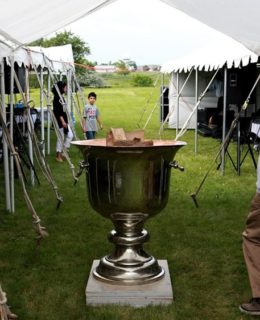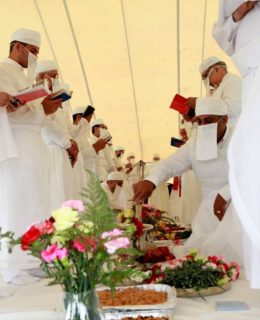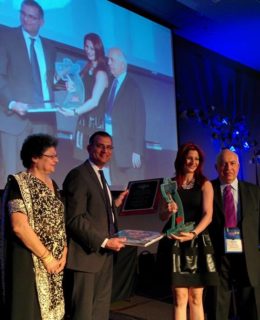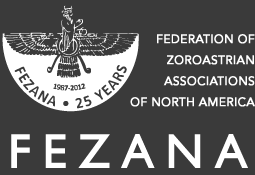FEZANA is a non-profit religious group registered in the state of Illinois and formed to function as the coordinating organization for Zoroastrian Associations of North America.
FEZANA serves as the coordinating body for 27 Zoroastrian Associations in the United States and Canada.
FEZANA is registered as a non-profit, religious and charitable organization in the USA.
REGISTERED ADDRESS:
8615 Meadowbrook Drive,
Burr Ridge, IL 60527 USA
FEZANA is a non-profit religious Corporation registered in the State of Illinois. Federal Tax ID Number: 36-3521343
The FEZANA Charter
FEZANA is incorporated under the not-for-profit corporation laws of the State of Illinois, exclusively for religious and charitable purposes.
- To function as a coordinating organization for Zoroastrian Associations in North America;
- To promote the study, understanding and practice of the Zoroastrian faith and the welfare of Zoroastrian communities;
- To promote, perpetuate and teach the Zoroastrian religion as set forth in the teachings of the Prophet Zarathushtra and the Zoroastrian faith;
- To gather and disseminate information to Zoroastrian Associations and others relating to the Zoroastrian faith and communities;
- To foster and encourage Zoroastrian fellowship in the North American continent, and to represent the religious interests of its Membership in national and international forums;
- To engage in charitable activities as required by the Zoroastrian faith, and consistent with the laws of Canada and the U.S.A. pertaining to religious and charitable organizations; and
- To engage in and support any other activities that nurture and support the Zoroastrian faith and Zoroastrian communities.
Nothing in these purposes shall be construed to impair the religious and administrative autonomy of individual Associations or individual Zoroastrians.
History
The following is adapted from an article by Mr. Rohinton Rivetna in the Summer 1996 issue of the FEZANA Journal.
EARLY ATTEMPTS TO CREATE A NORTH AMERICAN FEDERATION
The first attempt to organize Zoroastrians into a North America-wide organization, called the Zoroastrian Association of America (ZAA), was made in 1965 by Mr. Keki Bhote, Mr Jim Modi and some others. The vision of a North American organization was perhaps ahead of its time. Mr. Bhote wrote in its newsletter: ” … it is time now, for those of us in the vanguard of this migration, to plan on ways and means to preserve our identity and our heritage while participating fully in the American way of life… therefore thirty of us in the Chicago area have started the Zoroastrian Association of America on May 23, 1965″. Unfortunately, the concept of a continent-wide association did not catch on and received some opposition from people who were attempting to start local associations in Canada . ZAA functioned, primarily in the Chicago area, for 3 or 4 years; then gradually ceased activities.
A second attempt to form a United Zoroastrian Associations of North America (UZANA) was made by Dr. Jehan Bagli of Montreal between 1976 and 1978. A meeting of Association representatives from Toronto, Chicago, New York and Montreal was held in Montreal to discuss the formation of this body. Mr. Lovji Cama of New York was assigned the task of pursuing the development further. Due to lack of interest and lack of a clear mandate from the people, UZANA never took off.
AN IDEA TAKES ROOT
Meanwhile, the idea for the federation was being crystallized in the minds of many Zarathushtis and discussed informally during biannual North American Congresses held in various parts of the continent since 1975. The organizers of the Fifth North American Congress in Los Angeles in 1985, Mrs. Farangis Shahrokh and Mrs. Dhunmai Dalal, placed on the congress agenda, a session on: “Proposal for the Organization of a North American Zoroastrian Body”. The session was chaired by Mr. Rohinton Rivetna of Chicago. Mr. Homi Minocher Homji of Toronto presented a proposal for a well-structured, hierarchical North American Federation. A straw poll after the session overwhelmingly approved the ideas presented by Mr. Homji. However, a small but vociferous group, raised objections because they felt that a federation may squelch the voice of the local Associations.
THE MANDATE
The Los Angeles Congress will be remembered for its direct confrontation on critical issues ranging from conversion and acceptance, to the seed for the formation of federation. Never before was witnessed such open hostility among Zarathushtis in a public forum. The Congress gave the mandate to Mr. Rohinton Rivetna to write a draft constitution, and carry the proposal forward. A core group was chosen to sound off the ideas, taking pains to include individuals from the objecting groups. Following the Congress, the work proceeded at full speed. Within four months a draft constitution was prepared by Mr. Rivetna and circulated to the core group for comments.
CONSTITUTIONAL CONVENTION
After a couple of iterations with the core group, a Constitutional Convention was called in Chicago in May 1986 to review the draft. Representatives from nine Associations came and deliberated round the clock for two long days. The delegates were: Mr. Firdosh Mehta (Alberta), Mr. Furrokh Dastur (California), Mssrs. Bomi Damkevala, Kayomarsh Mehta, Keikhushroo Mobed, Rohinton Rivetna and Mrs. Roshan Rivetna (Chicago), Mr. Hushtasp and Mrs. Perviz Bhumgara (Manitoba), Prof. Kaikhosrov and Mrs. Peroja Irani (New York), Mrs. Dina G. McIntyre (Pennsylvania), Mr. Kaemerz Dotiwala (Texas), and Mr. Rohinton M. Tengra (Washington, D.C.).
Each delegate was given the responsibility of chairing the discussion for one or more sections of the draft constitution. Every line and every word was debated (without regard to pride of authorship) with frankness and mutual respect until a consensus was reached on the content of the section. To Alberta, represented by Mr. Firdosh Mehta, goes the honor of adding the “E” to FEZANA (the original draft used FZANA). To Washington D.C., represented by Mr. Rohinton Tengra, goes the credit of word-smithing the text of the Preamble. Attorney Dina McIntyre of Pittsburgh lent her legal expertise at every step. In the end, the collective wisdom of the delegates had evolved the original draft into a strong, viable document.
BUILDING A CONSENSUS
After the convention, consultations continued to polish the language, cross all the t’s and dot all the “i’s; and finalize the document. After several more iterations of drafts, a multitude of phone calls and mailings (no e-mail in those days), consensus was reached on the final wording of the FEZANA Constitution from every one of the 16 Associations of record in 1986. Rivetna writes in the FEZANA Journal: “it was like seeing a flower bud emerge and blossom before one’s eyes.” A final parchment copy was sent to each Association, with a signature page that was returned with each Association President’s signature.
FEZANA IS BORN
FEZANA was registered in the State of Illinois on June 2, 1987 as a non-profit, religious and charitable organization. The first Annual General Meeting was held in Toronto on April 1, 1988, in conjunction with the sixth North American Zoroastrian Congress. The first elected Officers were: Mr. Rohinton Rivetna (Chicago), President; Mr. Homi B. Minocher Homji (Toronto), Vice-President; Mr. Framroze Patel (New York), Treasurer; Mrs. Dolly Dastoor (Montreal), Secretary; and Mrs. Sabar Balsara (Toronto), Assistant Secretary. FEZANA received tax-exempt status in the United States on June 19, 1989, with tax I.D. No. 36-3521343.
Over the years, the FEZANA Constitution has proved to be a viable document that has helped to resolve many questions and issues related to the orderly progress of a diverse and growing Zarathushti community in North America. The Constitution has undergone two minor revisions.




